| |
Observing
tips: Look
west 30 to 60 minutes after sunset when
the Sun has dipped 6o to 16o below the horizon.
If you see luminous blue-white tendrils spreading across the sky,
you've probably spotted a noctilucent
cloud. Although
noctilucent clouds appear most often at arctic latitudes, they have
been sighted in recent years
as far south as Colorado, Utah and Virginia. NLCs are seasonal,
appearing most often in late spring and summer. In the northern
hemisphere, the best time to look would be between mid-May and the
end of August. See also 2003,
2004, 2005,
2006, 2007,
and 2008 |
 |
| |
| |
Photographer,
Location |
Images |
Comments |
|
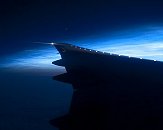
|
Bryan Tobias,
36,000 ft altitude a few hundred miles south of Greenland
en route to Frankfurt, Germany.
Jun. 16, 2009 |
#1,
#2, #3,
#4 |
Absolutely beautiful! The flight crew didnt know what they were and a flight attendant notified the pilot that I was taking photos and knew what the phenomenon was. They asked for me to e-mail them the photos once we returned! A very interesting flight! Couldn't sleep because they were so beautiful.
|
|
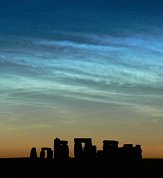
|
Grant Privett,
Stonehenge, Wiltshire, UK.
Jun. 17, 2009 |
#1 |
Stonehenge with a backdrop of brilliant noctilucent clouds on the night of the 17th-18th June. Taken a little after 2315BST. The cloud changed quite rapidly and at this point was nearest its brightest though the contrast was more intense 15 minutes later.
Taken using an 8 second exposure with a Panasoic Lumix DMC-FZ7.
It would have been pretty near impossible to take a bad photo and it was worth standing 5ft from the speeding lorries on the A303 trunk road.
Not a night I will ever forget.
|
|
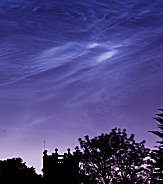
|
Andrew Phethean,
Aberdeen, UK
Jun. 18, 2009 |
#1,
#2,
#3,
more |
Hope there's still space for some more NLCs! As Martin Mckenna says - it was a display of a lifetime. Shadows indeed! It was actually the first time I'd ever seen these but it was better than any photos I've seen up till now. Incredibly bright, and stunningly detailed. Attached is
1. a panorama of two stitched 4 sec images (f/5.6, ISO 200) from a Canon 450D with kit lens at 18mm.
2. this shows Capella and other stars of Auriga shining through (also 4 sec at f/5.6).
3. A close up of the delicate structure (also...)
Taken around 1am in N
|
|
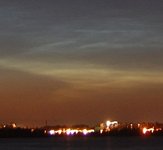
|
Alexander Mednick,
Dniepropetrovsk, Ukraine.
Jun. 19, 2009 |
#1,
more |
NLC after sunset! Dniepropetrovsk, Ukraine.
48°28’17.2”N 35°02’55.8”E
19 jun 2009, 19:29:57 GMT (22:29:57 local)
Nikon D40, ISO 400, f/3.5, 8 sec exposure.
|
|
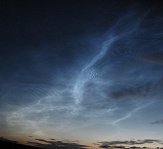
|
Ian Brantingham,
10 miles south of Banff, Scotland
Jun. 18, 2009 |
#1 |
The brightest and most incredable display I have ever seen, it even cast shadows. My photo looks like a Chinese dragon. canon powershot a540 1/2 sec @ 2.8
|
|
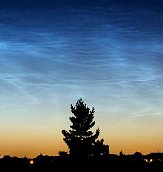
|
Maurice Gavin,
from home Worcester Park SW London
Jun. 19, 2009 |
#1 |
Best dawn NLC for a some years - wife and I watched it from the comfort of the pillow before dawn - amazing! NLC extended 100 deg of horizon from NNW to due east near rising crescent moon+Venus. 1st pic taken with cam [Fuji E550 - 3s exp f/3 @ 400 ISO] propped on bedroom window cill.
|
|
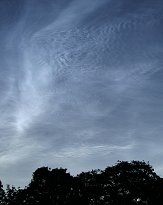
|
Alan C Tough,
Elgin, Moray, Scotland.
Jun. 18, 2009 |
#1 |
Absolutely breathtaking! This NLC display was so extensive I wished I'd bought that 10-20mm lens! The attached image was taken at 00:22 UT on June 18, 2009. Equipment used: Canon EOS 300D, 24-60mm Sigma EX DG lens. Exposure details: 2 Secs @ f/3.2, ISO-200.
|
more
images: from
Anthony W Cross of Manchester UK; from
Graham Bate of East Yorkshire, England; from
Marcin of Szubin, Poland; from
Marek Nikodem of Szubin, Poland; from
Michal Laszczynski of Gdynia, Poland; from
Steve Loveridge of Taunton England;
|
|
|








